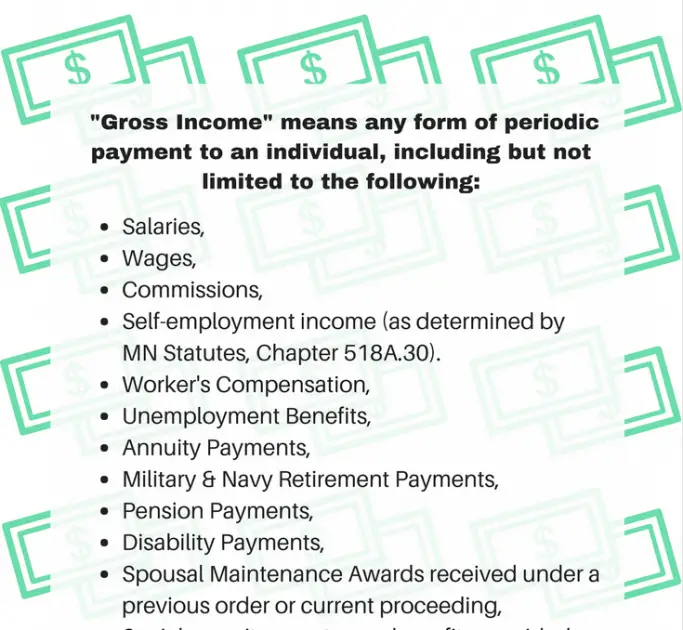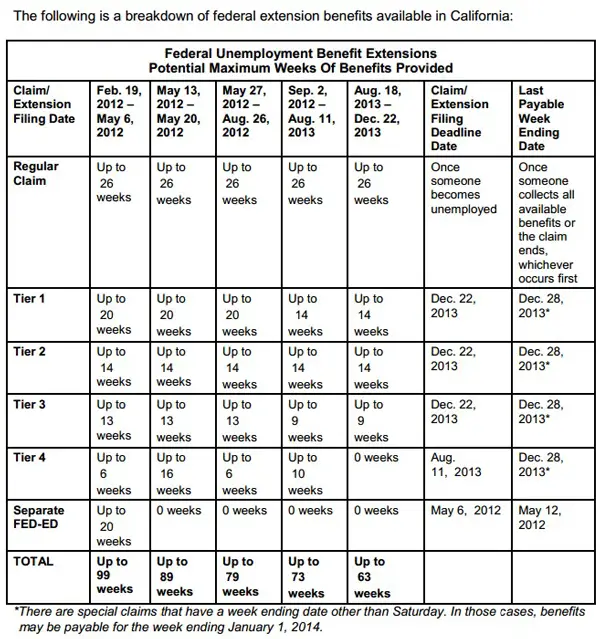May Employees Who Work Reduced Hours Receive Partial Unemployment Benefits
Yes. As noted above, an individual is considered unemployed in any week of less than full-time work, if the wages payable to them with respect to the week, when reduced by $25 or $25% of the wages payable, whichever is greater, do not equal or exceed their weekly benefit amount. Once it is determined that the individual is unemployed and qualifies for partial UI benefits, then the EDD will calculate their weekly benefit amount and reduced weekly benefit amount. The following example is used to illustrate how a reduced weekly benefit amount is calculated.
Assume that the individual earns $13 per hour and has worked five days a week or 40 hours for the previous 15 months .
Determine if the individual can establish a valid UI benefits claim based on their previous wages. To establish a valid UI claim, the EDD looks at the highest base period quarter to see if the individual earned at least $1,300 or the highest base period quarter to see if the individual earned at least $900 and whether the total base period earnings added together equals 1.25 times the individual’s highest base period quarter earnings
Using the standard base period method, the individual’s highest base period quarter is:
- $13 per hour x 40 hours per week = $520 per week
This individual is earning $6,760 in their highest base period, which is more than the $1,300 needed to establish a valid UI benefits claim.
What Is The Ui Rate For California 2021
According to a statement on the California Employment Development Departments website, the unemployment tax rate in California will remain unchanged in 2022. Unemployment tax rates will remain unchanged as of January 1, 2022, ranging from 1.50% to 6.20%. It is also expected that the new employer tax rate will remain stable at 3.40%.
How To Calculate Unemployment
wikiHow is a wiki, similar to Wikipedia, which means that many of our articles are co-written by multiple authors. To create this article, 15 people, some anonymous, worked to edit and improve it over time. This article has been viewed 427,584 times.Learn more…
When you find yourself unemployed, the fear of the unknown can be overwhelming. Unlike certain other benefit programs, unemployment payments are calculated as a percentage of your past wages. To ease your mental burden during this difficult time, it can be a good idea to estimate the size of your unemployment payments in advance of your first payment so that you can prepare to budget accordingly. If you’re not interested in calculating your own unemployment benefits but would like to learn how to calculate the unemployment rate of a country, read this article instead. If you’d like to calculate your own unemployment benefits, see Step 1 to get started.
You May Like: Can Unemployed Apply For Medicaid
How Much Unemployment Do You Get In California
In California, someone is considered “unemployed” during any week in which the person’s regular wages, minus $25 or 25% of those wages , is less than he or she would earn as a weekly unemployment benefit. In this situation, an employee who meets the other eligibility requirements would receive a check for the difference.
What Is Unemployment Based On

These unemployment benefits provide a partial replacement for lost wages. The amount that you receive would be based on what you had earned. States have different formulae to calculate benefit payments but all states would take your prior earnings into account. While others look at the employees earnings during the highest paid quarter or two quarters of the base period.
Don’t Miss: State Taxes On Unemployment Benefits
State Disability Insurance Tax
The SDI program provides temporary benefit payments to workers for non-work-related illness, injury, or pregnancy. SDI tax also provides Paid Family Leave benefits. PFL is a part of SDI and extends benefits to people who cant work because they need to:
- Care for a seriously ill family member.
- Bond with a new child.
- Participate in a qualifying event because of a family members military deployment.
SDI is a deduction from employees wages. Employers withhold a percentage for SDI on a portion of wages.
For More Information
Eligibility Requirements For California Unemployment Insurance Benefits
Managed by the California Employment Development Department , the UI program is a form of insurance that almost all employers pay into on behalf of their workers. The employers payments collectively cover the cost of the unemployment benefits paid to all employees laid off or furloughed, or whose hours are sharply reduced.
To be eligible for this benefit program, you must a resident of California and meet all of the following:
- Unemployed, and
- Worked in California during the past 12 months , and
- Earned a minimum amount of wages determined by California guidelines, and
- Actively seeking work each week you are collecting unemployment benefits.
Don’t Miss: Can You Apply For Unemployment And Disability
Employers Subject To California Ui Tax
In California, the Employment Development Department administers the UI program according to guidelines established under federal law, the California UI Code, and the California Code of Regulations, Title 22.
California UI tax is covered by state payroll taxes. Moreover, unlike other states, California uses the same forms for UI tax, withholding taxes, and other employer taxes and refers to all these taxes under the general label of payroll taxes.
There are four categories of California payroll taxes. Among them, Unemployment Insurance and Employment Training Tax are employer contributions while State Disability Insurance and Personal Income Tax are withheld from employees wages.
Employers subject to California UI tax contribute to the UI fund, which pays benefits to people who are unemployed through no fault of their own. Most employers are tax-rated employers, which means the experience rating method is used to determine their UI contribution rate. Nonprofit and public entity employers that choose another method are known as reimbursable employers.
New employers subject to California UI tax are assigned a 3.4 percent UI rate for two to three years. After that, their contribution tax rate varies, depending in part on how much they have paid in UI benefits. The rate schedule for California UI tax and the amounts of taxable wages are determined annually.
Calculating Unemployment Benefits In California
Unemployment, whether expected or unexpected, is something most people go through at some point in life. No matter the circumstances, it is often a stressful time. Navigating confusing unemployment benefit calculations only adds to the stress. Unemployment benefits are there to see individuals through until they can find work. Understanding eligibility, as well as the amount of monthly unemployment benefits one can expect to receive, can aid in budgeting and planning for the period of unemployment.
Don’t Miss: Dept Of Labor Unemployment Ct
How To Calculate Total California Employer Payroll Taxes
Given that there are four different taxes to track, calculating all of your CA employer payroll taxes can be overwhelming, particularly if you’re a new employer. You can make the task easier by breaking it down into distinct steps.
-
Determine taxable wages
This is the most important step as all calculations will be based on this number. Use the CA EDD’s table that includes examples of how you can calculate the taxable wage for your employee.
-
Calculate UI and ETT
These are the California employer taxes that you’ll be paying. Calculate your liability according to your rates. The EDD website lists the current UI rates and you’ll have to log in to see your specific rate.
This is one of the simpler steps. Use the current SDI rate, 1.1 percent in 2022, and withhold the amount from your employee’s paycheck.
Similarly, calculate the PIT for your employee using the two methods for withholding schedules offered by California:
Method A – Wage Bracket Table Method
Method B – Exact Calculation Method
Who Is Eligible For Unemployment Benefits
An individual seeking unemployment benefits must first meet certain requirements for eligibility in the state of California.
- The individual is willing and able to work.
- He or she is actively looking for work every week.
- The cause of termination or layoff was no fault of his or her own.
- He or she is willing to accept work immediately.
It is important to note that if the individual quit his or her last job by choice, he or she must contact a representative to determine eligibility. Some instances of quitting are acceptable, but many are not.
If the person receiving unemployment benefits opts to participate in government-funded job training or continuing education, he or she is not required to look for a job while actively attending that training program. Likewise, if he or she is offered a job during that time, it is acceptable to turn down the job to continue with the training while receiving unemployment benefits. This allows the individual to take advantage of skills learned in job training.
Also Check: How Much Tax Do You Have To Pay On Unemployment
How Much Will Your Benefits Be
Once you file for unemployment and are approved, you will begin to receive benefits. Your benefits might come in the form of a check, but more often they will come in the form of a debit card or direct deposit to your bank account. It varies by state. You typically can file weekly online, by email, or by phone.
The amount you receive depends on your weekly earnings prior to being laid off and on the maximum amount of unemployment benefits paid to each worker. In many states, you will be compensated for half of your earnings, up to a certain maximum.
State benefits are typically paid for a maximum of 26 weeks. Some states provide benefits for a lower number of weeks, and maximum benefits also vary based on where you live. In times of high unemployment, additional weeks of unemployment compensation may be available.
Regardless of how much you make, you can’t collect more than the state maximum.
How Are Partial Weekly Benefits Calculated

First, calculate the individual’s weekly benefit amount. The weekly benefit amount is the amount that the individual would receive if they were totally unemployed. The individual’s weekly benefit amount is determined by taking the amount of wages that the individual earned in their highest base period quarter and comparing it to the EDD’s Unemployment Insurance Benefit Table here. In this scenario, the individual is earning $6,760 in their highest base period quarter. Using the EDD’s Unemployment Insurance Benefit Table, the individual’s weekly benefit amount is $260, which is the amount they would receive if totally unemployed.
Second, if the individual’s hours are reduced from 40 hours per week to 24 hours per week, determine if the individual is unemployed and if they are eligible for partial UI benefits. To do so, look at whether the individual is working less than full time and whether the wages payable to them with respect to the week, when reduced by $25 or $25% of the wages payable, whichever is greater, do not equal or exceed their weekly benefit amount. Assume the individual’s weekly benefit amount is $260, as calculated above.
In this scenario, the individual is eligible for partial UI benefits:
This individual’s reduced weekly benefit amount is calculated as follows:
Also Check: Instant Loan App For Unemployed
What Are The Factors That Affect Unemployment
Other Factors That Impact Eligibility 1 An individual must be physically able to work.#N#If sickness or injury is prohibiting work, he or she should apply for Disability Insurance. 2 The individual must be in satisfactory immigration status and authorized to work in the United States. 3 If the individual cannot work due to a disaster, he or she may be eligible for UI or Disaster Unemployment Assistance. 4 If it is determined that the person is not eligible for UI, he or she has the right to file an appeal.
How Is The State Unemployment Tax Calculated
Like other payroll taxes, you pay SUTA taxes on a percentage of each employees earnings, up to a certain amount.
Your SUTA tax rate falls somewhere in a state-determined range. States assign your business a SUTA tax rate based on industry and history of former employees filing for unemployment benefits. New companies usually face a standard rate.
Each state decides on its SUTA tax rate range. The ranges are wide: Kentuckys range, for example, is 0.3% to 9%.
Each state also decides on an annual SUTA limit so that an employees earnings after that amount are no longer taxed until the following year.
You might know that Social Security taxes stop after an employee earns $137,700 for the year. The SUTA limit, also called a SUTA wage base, is the same concept.
Recommended Reading: Va Form For Individual Unemployability
Calculating California Unemployment Benefits
Most UI applicants will receive a weekly benefit amount of between $40 to $450 over 26 weeks. However, an increase in benefits is possible in times of high employment. For example, in March 2020, the EDD, in conjunction with the federal government, increased UI benefits due to the COVID-19 pandemic. These will end the first week of September 2021, and California will go back to its regular benefit totals.
An applicant who made $6,000 over their base period’s highest quarter will get $231 each week in UI benefits. Those whose highest-quarter wages were a minimum of $11,674 will get $450 each week. The EDD has an online calculator for applicants who want to know how much they’ll get in benefits.
When entering information about their wages in the calculator, it’s important to remember California counts only W-2 earnings, not 1099 income from independent contracting or passive income. An applicant can also look at the highest earnings in their base period and check them against the EDD’s Unemployment Insurance Benefit Table.
How Do I Calculate My Unemployment Benefits In California
Gather your pay from the first four of the most recent five calendar quarters that you worked for the purpose of calculating your states unemployment rate.Then, identify which of those calendar quarters was the one in which you made the most money.Next, divide the total salary received in that quarter by 25 and round to the closest dollar for an estimate of your weekly benefit allotment .
Your total wages for the base period quarter in which you had the highest earning potential will be used by the EDD in the calculation of the amount of your weekly assistance payment. To calculate the maximum weekly benefit amount of $450, total wages are divided by 26 for all workers other than those making extremely low salaries. This yields the weekly benefit amount.
Recommended Reading: Unemployment Lawyers In Washington State
How Is Unemployment Calculated In California
how your California unemployment is calculatedWages in your 2 highest quarters of your base year are added up and divided by 26, that is your weekly amount. However benefits can not exceed $450California government estimatorCalifornia unemployment benefits table
What happens if your weekly benefit amount calculation is over the $450 weekly maximum set by the State of California? If you are someone who earns more than this amount annually you will just receive the weekly maximum. Currently, that is the maximum amount of unemployment weekly benefits that are allowed. That amount may go up as the cost of living continues to increase but as for right now it is capped at weekly.
Additional California Payroll Tax Resources:
Our calculator is here to help, but of course, you can never learn enough, especially when it comes to payroll taxes. Here are some additional resources and contact information to help you run California payroll:
State of California Employment Development Department : 333-4606 | E-Services for Business | Register Online
Franchise Tax Board : 852-5711
Being a California employer isnt always easy. If you want to take some of the administrative burdens off your shoulders, there are a number of terrific payroll software companies that can do all the heavy lifting for you.
LET’S DO THIS
Recommended Reading: Where Is My Unemployment Card
What Are Unemployment Benefits
Unemployment benefits is a joint federal-state program. It provides temporary benefit payments to employees that are fired without any reason or forced to quit. You are paid unemployment benefits for only a few weeks. These differ based on the state in which you reside until you find another job. Sometimes, it could be hard to find another job as several unemployed people have no work for a year or more. Based on these tough economic times, the federal government has passed several extensions that make unemployment benefits available for a longer period.
These unemployment benefits provide a partial replacement for lost wages. The amount that you receive would be based on what you had earned. States have different formulas to calculate benefit payments but all states would take your prior earnings into account. While others look at the employees earnings during the highest paid quarter or two quarters of the base period.
Other Factors That Impact Eligibility

A few other requirements must be met in order to be eligible for unemployment benefits.
- An individual must be physically able to work.
- If sickness or injury is prohibiting work, he or she should apply for Disability Insurance.
Read Also: What Is The Maximum Unemployment Benefit In Illinois